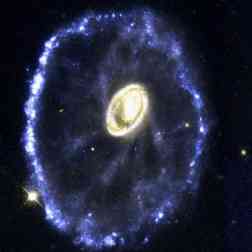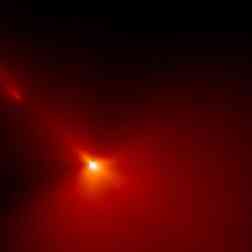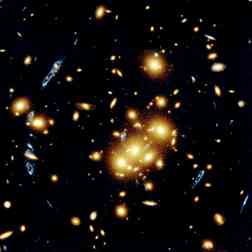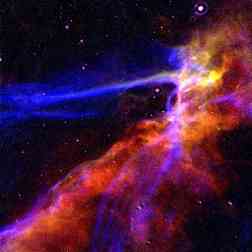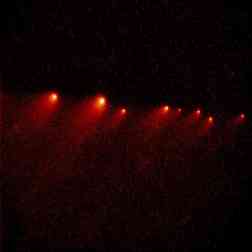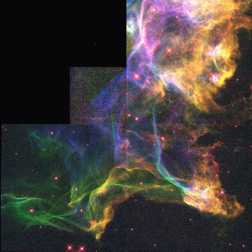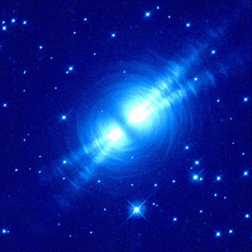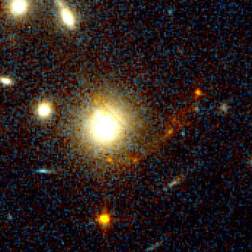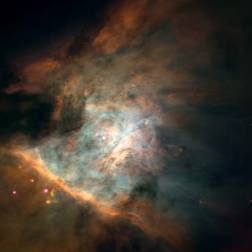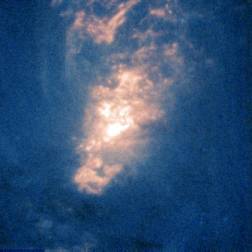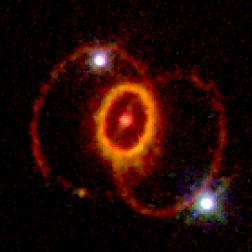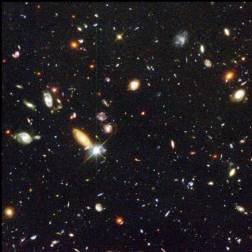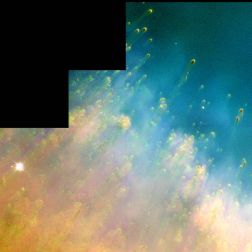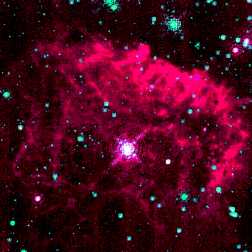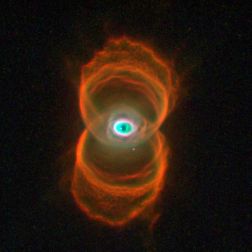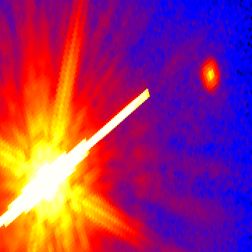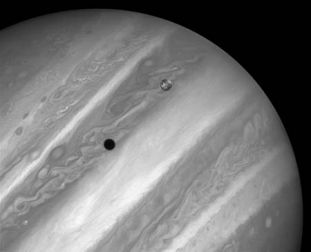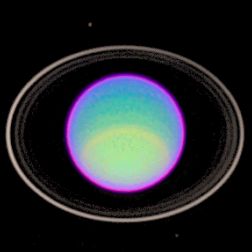Descripción |
Fotografía |
La Galaxia Cartewhell, un extraño y espctacular colisión entre dos galaxias localizadas a 500 milliones de años-luz en la constelación Sculptor. |
|
El Cometa Hyakutake, fotografiado a las 20:30 del Lunes 25 de Marzo de 1996, cuando este pasaba tan solo a la distancia de 9.3 milliones de millas de la Tierra. |
|
Esta imagen muestra varias galaxias y estrellas, tambien se observa unas manchas azules producidas por grandes masas de gases. |
|
Una pequeña parte de los restos de la supernova Cygnus Loop, cuyas marcas de un extremo son la onda expansiva de una inmesa explosión estelar de hace 15.000 años. |
|
Una combinacion de imagenes HST a luz visible muestran la evolución temporal de la zona brillante del cometa P/Soemaker-Levy 9, en su ruta impacto con el planeta Jupiter en Julio de 1994. |
|
En el centro de la Nebulosa de Cancer está situado el Pulsa Cancer, el colapsado alma de la estrella explosionada. |
|
Gas a gran velocidad proveniente de la explosion de una supernova en la constelacion Cygnus suelto en las oscuras y frias nubes de materia intelestelar. Encabezado por esta gran ola de energía, las nubes crecen, con colores similares al neon. |
|
| This image of the Egg Nebula, also known as
CRL2688, shows a pair of mysterious "searchlight" beams emerging from a hidden star, criss-crossed by numerous bright arcs. |
|
| This infrared image of the Egg
Nebula, seen in the previous photo, reveals star light reflected by dust particles (blue) and hot molecular hydrogen (red). |
|
| The bright orange arc and orange "star" at
the bottom of the photograph are galaxys in formation 13 billion light years from Earth - less than a billion years after the "Big Bang." The orange color is due to the tremendous red shift of light, which indicates the age of a distant object. |
|
| In a mosaic of 15 images, The Great Orion Nebula displays red light where emissions are nitrogen, green for hydrogen, and blue for oxygen |
|
| NGC1068 is located at a
distance of approximately 60 million light years, and is the prototype of a class of galaxies known as Seyfert Type 2. |
|
| An eerie, nearly mirror-image pair of red luminesent gas "hula-hoops" frame the expanding debris of a star seen as a supernova explosion in 1987 |
|
| Several hundred never before seen galaxies are visible in this "deepest-ever" view of the universe, called the Hubble Deep Field. |
|
| Dubbed "cometary knots" because their
glowing heads and gossamer tails resemble comets, the gaseous objects in the Helix nebula probably were formed during a star's final stages of life. |
|
| Each gaseous head of these cometary knots in the Helix nebula is at least twice the size of our solar system; each tail stretches 100 billion miles, about 1,000 times the Earth's distance to the Sun |
|
| pistol,
one of the brightest stars in our galaxy, appears in this
image. Taken with the Near Infrared Camera and Multi-Object Spectrometer (NICMOS), Hubble is able to peer through obscuring dust into the very center of the Milky Way |
|
| This image reveals the true shape of MyCn18 to be an hourglass with an intricate pattern of "etchings" in its walls. |
|
| One of the least massive and coolest stars ever seen (upper right), it is a diminutive companion to the K dwarf star GL 105A (HD 16160). |
|
| Jupiter's volcanic moon Io
passing above the turbulent clouds of the giant planet, on July 24, 1996 |
|
| Using infrared filters, Hubble captured detailed features of three layers of Uranus' atmosphere. |
|
| Jupiter, showing the impact damage caused by its encounter with Comet P/Shoemaker-Levy 9 (1993e), fragments G and Q2, in July 1994. |
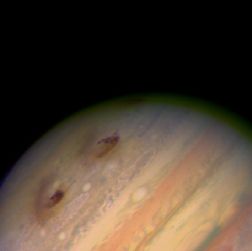 |
| The HST can resolve individual stars in other
galaxies, making it invaluable for identifying a rare class of pulsating stars, called Cepheid Variable stars, embedded within M100's spiral arms. |
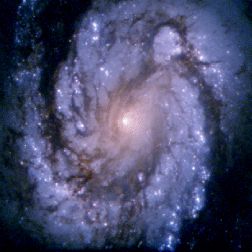 |
| These eerie, dark pillar-like structures are columns
of cool interstellar hydrogen gas and dust, part of the "Eagle Nebula" M16, a star-forming region 7,000 light-years away. |
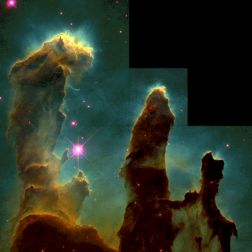 |
| This superb HST image reveals a pair of one-half
light-year long interstellar "twisters" - eerie funnels and twisted-rope structures - in the heart of the Lagoon Nebula which lies 5,000 light-years away in the direction of the constellation Sagittarius. |
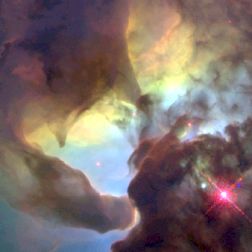 |
| In this "pre-repair" HST photo, the core of
nearby spiral galaxy M51 contains a striking, dark "x" silhouetted across the galaxy's nucleus, marking the position of a suspected black hole. |
 |
| This June 27, 1997 HST image of Mars
indicates the location of the Pathfinder Lander as it bounced to a resting place on a windy, cloudy Mars morning, July 4, 1997. |
 |
| Eta Carinae, site of a
supernova about 150 years ago, became one of the brightest stars in the southern sky. The explosion produced two polar lobes and a large, thin equatorial disk, all moving outward at about 1.5 million miles per hour. |
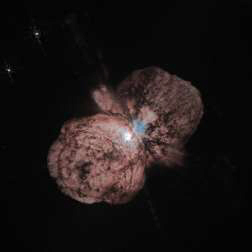 |
| Neptune's powerful equatorial jet,
where winds blow at nearly 900 mph, is centered on the dark blue belt just south of Neptune's equator. |
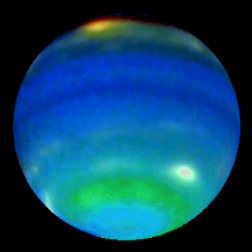 |
